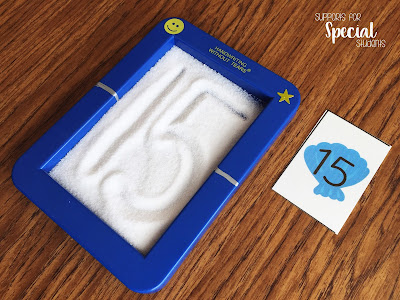More testing.
More themes.
More projects.
More ......
There is so much to squeeze into the day. How do you fit it all in?
Whenever possible, I like to find a way to work on two skills at once. One of my favorite ways to maximize my time is by incorporating fine motor practice into my math instruction.
Here are my top 15 activities:
1. Sensory bins - Who doesn't love a good sensory bin!?! Toss in a few manipulatives and have the students pull them out with tweezers. Use the manipulatives to count, create a pattern, or as a sorting task. I love to use the mini erasers from the Target Dollar Spot.
2. Number beads - It is surprising how much skill and focus it takes to string beads onto a pipe-cleaner. These cards are from my Summer Counting Pack, but they are also easy to make! Cut an index card in half, write a number on the card, punch a hole and attach half a pipe cleaner.
3. Lego counting - Why not incorporate play AND fine motor into your math activities!?! My students love to work on sequencing numbers using Legos. They are perfect for counting up to 10, counting backwards, and skip counting.
4. Salt tray - I typically use these salt trays during handwriting. However, I also like to pull them out during math for the students to practice writing their numbers. These trays are part of the Roll-a-Dough Letter kit from Learning Without Tears. This isn’t an affiliate link, I just love them! I set aside the letter mats and play dough and use them as a separate activity. I used a silver permanent marker to draw a mid-line on the tray. While I love the Roll-a-Dough trays, they are a bit pricey. Pencil boxes filled with salt work just as well.
5. Paperclip spinner - Who knew it was so easy to create a spinner! Flicking a spinner is a simple and fun way to build fine motor strength. Use a pencil to stabilize the paperclip and give it a spin! This spin and win activity is part of my Back to School Counting Pack, but you can also make a base for the spinner out of a simple piece of paper or an index card.
6. Clothes pin number sequence - I love any activity that involves clothes pins! I keep a few bins of clothes pins in different areas of the classroom so that they are always on hand. For this activity I used a simple paint stick that I picked up from a local hardware store (for free!). This is perfect for ordering numbers, skip counting, and even working on your phone number.
7. Lacing plates - You can easily differentiate this activity to focus on nearly any sequencing skill - Counting, skip counting, or ordering the numbers of a phone number.
8. Tweezers - I love to have my students use tweezers to count out manipulatives. I found these extra large tweezers at the Dollar Tree. This 20 frame mat is from my Back to School Counting Pack.
9. Hole punch number cards - Need a last minute activity? Grab a hole punch and index cards. Using a hole punch is a great way to build hand strength, not to mention the kids jump at the chance to punch holes in the paper!
10. Bubble wrap numbers - So simple, yet so motivating! Like most kids, my students LOVE to pop bubble wrap. There are so many ways that you can turn this into an academic activity. Have them pop the numbers in a sequence, count with 1:1 correspondence, or complete addition problems and pop the answers.
11. Cut up worksheet - Cutting up a worksheet full of math problems has two benefits. 1. It is great fine motor practice. 2. It makes the worksheet appear less overwhelming. My students love to cut up the worksheets and glue each problem onto a piece of construction paper. Sometimes they even race with their peers to see who can fill up their page first.
12. Hair bands on tongue depressor - This is an inexpensive activity that works on 1:1 counting and dexterity. I was able to pick up a pack of 100 hair bands at my local dollar store.
13. Clip cards - I keep a tub full of clothes pins next to each of my group tables. Clip cards are the perfect way to increase fine motor strength while working on academic activities! Do you want to know a secret? Not all of my clip cards are this pretty... I often make them on the fly using an index card. These cards are from my Summer Counting Pack.
14. Stickers - Peeling stickers is a great way to build up tiny finger muscles. Do you want to make it even more motivating? Find a pack of stickers with your students' favorite things. My sticker bin is full of princesses, Disney characters, superheros, and cars.
15. Lacing shapes - I have a GIANT bin full of these lacing activities. For years they sat unused. One day, one of my amazing paraeducators had the idea to write numbers on the back to help our students practice counting. This has been a game changer. These activities are finally getting used!
What are your favorite ways to incorporate fine motor into your academic activities? Please share!























